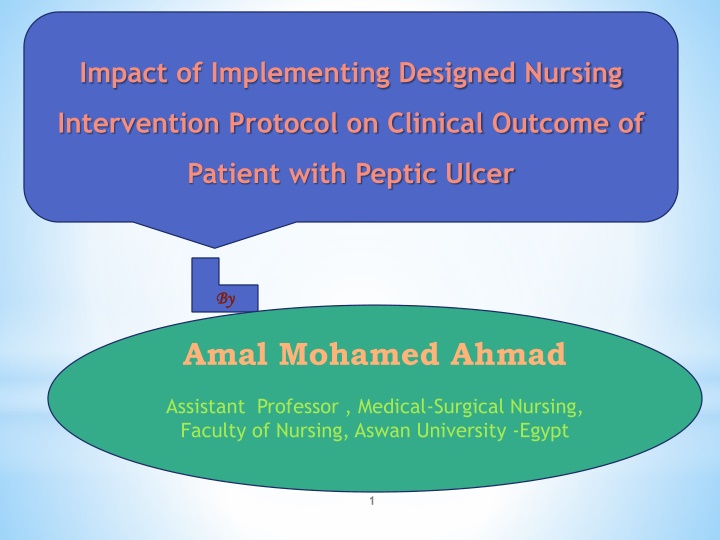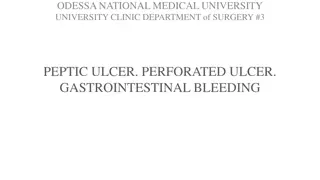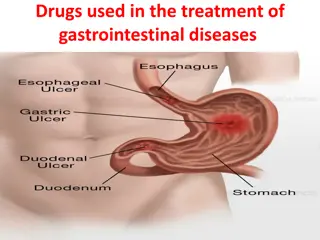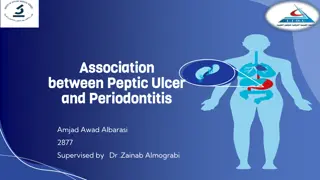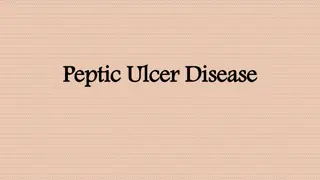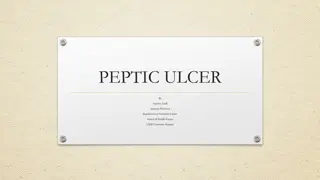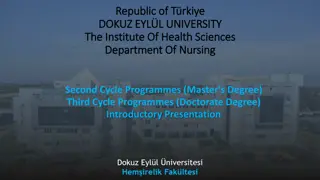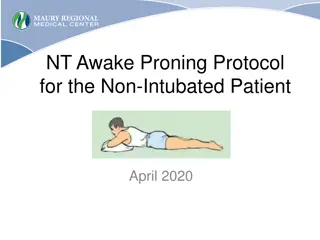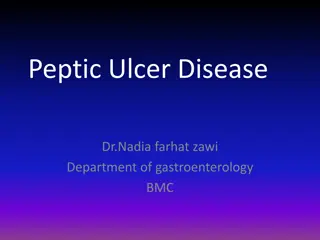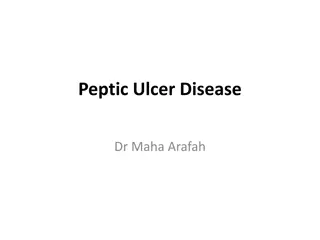Impact of Nursing Intervention Protocol on Peptic Ulcer Patients' Clinical Outcome
Peptic ulcer disease is prevalent globally, with varying incidences across different regions. This study focuses on the impact of implementing a designed nursing intervention protocol on the clinical outcome of patients with peptic ulcers, emphasizing the importance of nursing assessment, goals, and patient education for successful management and prevention. The significance of the study lies in addressing the increasing number of patients with gastric ulcers in Assiut Governorate.
Download Presentation

Please find below an Image/Link to download the presentation.
The content on the website is provided AS IS for your information and personal use only. It may not be sold, licensed, or shared on other websites without obtaining consent from the author.If you encounter any issues during the download, it is possible that the publisher has removed the file from their server.
You are allowed to download the files provided on this website for personal or commercial use, subject to the condition that they are used lawfully. All files are the property of their respective owners.
The content on the website is provided AS IS for your information and personal use only. It may not be sold, licensed, or shared on other websites without obtaining consent from the author.
E N D
Presentation Transcript
Impact of Implementing Designed Nursing Intervention Protocol on Clinical Outcome of Patient with Peptic Ulcer By By Amal Mohamed Ahmad Assistant Professor , Medical-Surgical Nursing, Faculty of Nursing, Aswan University -Egypt 1
Introduction Peptic ulcer disease occurs with the greatest frequency in people between the ages of 40 and 60 years. Men are affected three times more often than women. 2
* Introduction con .. In the United state of America(USA),it is estimated that 5% to15% of population has peptic ulcer and 4 million ulcer recurrences yearly (Garca and Hernandez 2008). 3
* Introduction con .. In Egypt, the incidence of peptic ulcer per year is approximately 8.1% as 6% men and 2.1% women . In Assiut, the numbers of patients with peptic ulcer during the period between 2008- 2009 presented to the endoscopy center of Assiut University Hospital was approximately (703) cases (Hospital Statistical Record, 2008). 4
* Introduction con .. The nursing assessment should includes pattern of pain, eating patterns, medications, history of ulcerogenic drugs, history of GIT bleeding, vital signs, physical examination and psychosocial history. 5
* Introduction con .. Often nursing goals include relief of pain, reducing anxiety, maintaining nutritional requirement, knowledge about the management and prevention of ulcer recurrence, absence of complications, promoting home and community- based care like teaching patients self-care to manage peptic ulcer disease successfully (Barkun et al.,, 2010). 6
* Introduction con .. Also she must instruct the patient to avoid certain medications, foods, tea, and coffee and restrict alcohol and smoking. The nurse reinforces the importance of follow-up care and reporting of recurrence symptoms 7
* Significance of the study It was observed in the last three years, increasing the number of patients with gastric ulcers in Assiut Governorate and many patient suffer from many health problem due to the presence of gastric ulcer, and lack of knowledge and dietary pattern as use spicy food and alcohol addiction and lack of awareness of a healthy lifestyle. 8
Significance of the study Hence, this study has been conducted to design intervention protocol for those for improvement in lifestyle pattern. Hopefully, the study results would generate attention and motivation for improving health and well being of this sector of patient . 9
* *This study was carried out in order to examine the impact of a designed nursing intervention protocol for patients with peptic ulcer on their life style as indicated by patients knowledge, practices, complications management, and life style change. 10
* Research hypotheses 1. The mean knowledge scores of the patients post intervention higher than those of pre intervention. 2. The life style of the study group subjects show more improvement than that of the control group subjects. 3. complications of peptic ulcer show less in study groups than control. 11
Design; A quasi-experimental research design was utilized. Setting ; This study was conducted at Assiut University Hospital Subjects: 60 adult peptic ulcer patients and divided into study and control group (30 for each) . 12
* Subjects and Method Con.. Inclusion criteria: include newly diagnosis of adult peptic ulcer patient, both sex, . free Chronic diseases as, chronic obstructive pulmonary diseases (COPD), diabetes mellitus, liver cirrhosis, hypertension, and not on steroid therapy and accepted to be participate in the study 13
* Con .. Subjects and Method Tools: Two tools were developed and utilized by the researcher to collect patient data based on review of literature. Tool I: knowledge assessment of peptic ulcer patient instruction interview schedule Part 1.Pre/ post structured interview questionnaire Part II: physical Assessment Tool II: Assessment of psychological Status: 14
Subjects and Method Con.. Method patients before the application of the nursing protocol intervention. purpose of the study was explained to the interviewed two times, the first interview was done before Endoscopy done and the second was done six weeks post Endoscopy done and after medical treatment is given. The patients of the control group were 15
Subjects and Method Con.. All patients received the designed protocol contents by the researcher herself, using lecture, posters and discussion were utilized as teaching methods. The designed protocol was conducted through three theoretical sessions and the duration of each session was around 30 to 45 minutes. Evaluation phase: was carried out for patient of both group pre and six week post implementing using of tool 1 and 2 . 16
Comparison between patient of both study and control at different interval pre & post intervention related to mean of the total knowledge scores Patient's knowledge Level of sign Study group Control p-Value group Mean+ SD Mean+ SD Total pre 62.53+ 2.36 63.11+ 2.37 0.1552 Ns Total post 94.98+ 2.09 63.24+ 2.49 0.001 ** ** 18
Relation between socio-demographic characteristics total mean of knowledge scores of both study and control group at pre and 6 week post intervention Socio- demogr. Knowledge Age Marital status Occupation Level of education T- value Value P-Value T- value P- Value T- value P- Value T- value P- Study groups NS Pre 0.93 NS 0.97 NS 0.65 NS 1.64 ** Six weeks post control groups 0.91 NS 0.71 NS 2.33 NS 11.45 Pre 0.26 NS 0.35 NS 1.29 NS 0.26 NS Six weeks post 0.22 NS 0.21 NS 1.69 NS 0.27 NS 19
* Correlation coefficient between Socio-demographic variables and the mean patient information about stressors obtained by the study and control groups as regards pre and after 6 weeks post application of destined protocol (n=30). Socio-demogr. Age Marital status Occupation Level of education P- Value T- value P- Value T- value P- Value T- value P- Value T- value Types of Stressors Study groups Pre 0.32 ns 2.60 ** 4.73 * 16.75 ** ** Six weeks post 0.1002 * 4.87 ** 6.73 ** 23.88 ** ** control groups Pre 0.26 ns 0.74 ns 2.o1 * 2.98 ns Six weeks post 0.22 ns 0.58 ns 0.16 ns 0.11 ns 20
Comparison between Patients of the study groups ( pre and after 6 weeks post intervention protocol) related to patient complains . A statistical significant difference was found between the study and control groups pre and after 6 weeks post protocol intervention for patient present complain related to epigastria pain, vomiting, diarrhea, constipation, distention and heart burn, respectively. as well as patient habit regarding smoking. 21
* Comparison between the study groups pre and post 6 weeks post application of intervention protocol as related to dietary pattern A Statistical significant difference was founded between the study groups pre and after 6 weeks post application of destined protocol for patient's diet habits as regard fats in cooking, and numbers of meals. 22
Nursing intervention protocol was proved to be effective in reducing patient complaining of stresses and improving patients total mean knowledge and improved life style. 23
Recommendations Establishment of education program to the nurse about peptic ulcer diseases to provide health teaching for the patients and to deal with the different needs of the patient especially physical and psychological needs. 24
Thanks 25
